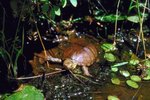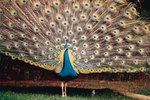
Russian tortoises are a small tortoise species that can be housed inside year-round, but they do best when they are placed in an outdoor enclosure during the warmer months. The natural sunshine is beneficial for your tortoise, as it allows them to synthesize vitamin D3, but before you put your tortoise outside, make sure that you have created a safe place for him to go.
Construct the Enclosure
When building an outdoor enclosure for a Russian tortoise, you want to build the enclosure to 10 times the length of your tortoise and five times the width. An average-size enclosure for one animal is 48 inches by 30 inches, and 1 foot in height. You can use different types of materials to create the walls of the pen; common choices are lumber, landscaping bricks, railroad ties and cement blocks. You want to use material that your tortoise cannot see through; if he thinks there is another side, he will try to get to it.
Make It Safe
When constructing the enclosure for your Russian tortoise, make sure that the pen is safe. Russian tortoises are diggers, so you want to create a barrier underneath the walls to that your tortoise cannot dig out. Cut hardware cloth about 6 to 10 inches wide and bury it under the walls, laying it flat about eight inches into the ground. Your tortoise may also try to climb out, so you'll want to create an overhang on the top of the pen, so that when he's at the walls of the enclosure and looks up, he sees the overhang and not the sky. If he thinks he spies a way out, he may try to go for it, and you don't want to find your tortoise missing because he dug out, or flipped over with a cracked shell because he tried to climb out.
Plant Vegetation
Plants are very important to add to the outdoor enclosure. They provide shade and food. You want to make sure that you offer edible plants, grasses and flowers for your tortoise. Hostas are a popular plant genus that contains several species; it is a perennial plant that is sturdy and hardy, making it great foliage for your tortoise enclosure. Dandelion, crimson clover and white clover are easy-growing weeds that are also edible. For safe flowers, plant English daisies, day lilies, peacock poppies and petunias, and for grass coverage, plant Kentucky bluegrass, Italian ryegrass, Bermuda grass and orchard grass.
Create Hiding Places
No matter how much shade the enclosure gets throughout the day, you want to make sure that your Russian tortoise has plenty of hiding places and caves. You can purchase a cheap plastic flower pot and cut it in half or bury half in the ground for a simple cave. You can also use cinderblocks or landscaping bricks to build a cave. No matter how your provide your tortoise with hidey-holes and caves, make sure to create a safe, sturdy cave so that it doesn't fall on your tortoise.
Where to Place the Enclosure
Placement is key. You want to find a location that will get late-morning and early-afternoon sunshine, and shade in the late afternoon. If you cannot find this ideal location, you'll need to engineer the lighting in your space by landscaping with plants, caves and shallow water dishes throughout the enclosure.
Photo Credits
-
BananaStock/BananaStock/Getty Images




